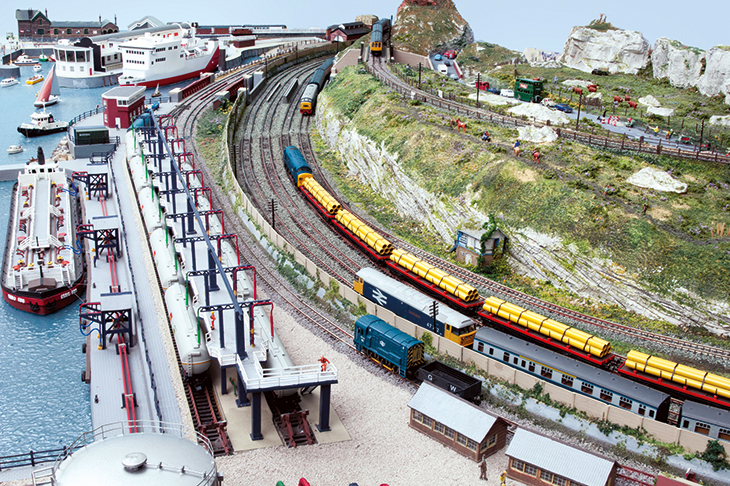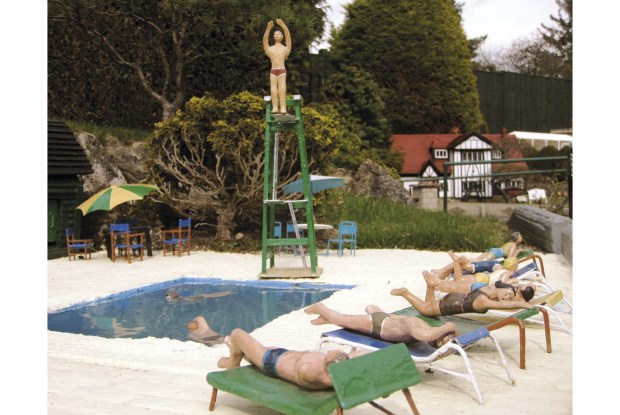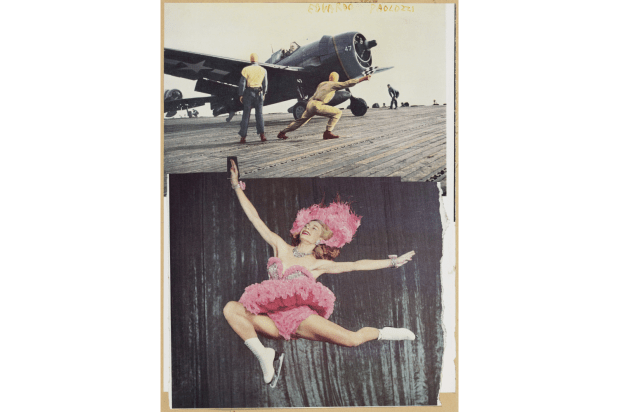It’s a summer day at Llangenydd station, and the afternoon train is already late, not that anyone seems to mind. A smartly dressed man has leaned his bicycle against the station’s water tower, and his terrier jumps up as he unwraps his sandwich. A commercial traveller, perhaps, or a professor from Liverpool University on a cycling tour of Snowdonia. Even though we’ve never been here before, we can guess where we are. The colour of the stone, the yellow gorse on the embankments, and the distant glimpse of the sea all tell us that we’re in the top left-hand corner of Wales. The weatherbeaten condition of the steam locomotive that wheezes into view suggests that we’re in the early 1960s: just a few years before Dr Beeching will sweep this whole scene into history.
Except, mercifully, he won’t, because Llangenydd never existed outside of a space six feet long and two feet wide. Of the 90 model railways at the 2019 Warley National Model Railway Exhibition — the combined Crufts and Royal Academy summer show of the model railway calendar — it’s not the most spectacular, though it might be the most typical. Railway modelling is an international hobby, with its own national styles and idioms. In UK homes, a small country station is often all that will fit in a spare room or garage. With imagination and craftsmanship, though, you can use that space to evoke a world. Llangenydd is an exquisitely observed and rendered variation on a very British theme: your own private Adlestrop.
There’s any number of these variations at the Warley show. Some are scale replicas of actual locations. Sydney Gardens focuses on the main line that slices through suburban Bath, complete with distant glimpses of Georgian terraces. Others capture an atmosphere without tying themselves to specifics. Diesels in 1970s BR blue throb beneath floodlights at an urban depot: little more than a diorama, really, but it catches the mood, and gives its creator a stage on which his trains — the real stars of the show — can perform. But that’s just one way of doing it. There’s always a good crowd for the ‘live steamers’: large-scale models powered by fire and water on the same principle as full-size locomotives. Remember in The Railway Children, when the model engine explodes? They’re safer these days, though they still dribble scalding water and leave that glorious smell of steam and hot oil as they rattle by.
Meanwhile, Japanese modellers have used the electric motors that make your mobile phone vibrate to create T-Scale: trains so tiny that you’re practically at risk of inhaling them. Digital decoders mean that layouts (please, never ‘train sets’) can now be operated from smartphones. Anything goes, and as long as it runs on rails, someone will love it. There are at least 350 model railway clubs in the UK, and the stereotype of the enthusiast as malodorous and male won’t survive a trip to the Warley show. Husbands and wives operate their layouts together, and small boys and girls squeal with glee as they spot the circling Quidditch players on a Harry Potter-inspired layout from the Channel Five series The Great Model Railway Challenge.
You’re laughing, aren’t you? Grown adults playing with toy trains. We’ve heard all the jibes, though since Rod Stewart outed himself as a railway modeller, we’ve been hearing them less (it seems to be a Dad Rock thing: Roger Daltrey, Neil Young and Phil Collins all have model railways too. Jools Holland’s layout featured in the titles of his BBC2 show). Each to their own: 15 million people in the UK regularly pay to watch 11 men kicking a ball into a net. It’s more troubling when the Guardian mentality goes to work on the hobby. Steam trains, nostalgia for the 1950s, a (literally) little England… well, you can guess the script.
They’ve not been to the Warley show, and seen the layouts that travel each year from Europe, bringing the Alpine air of Switzerland’s mountain-climbing Rhaetian Railway, or the battered electric trams that used to whir through the pine forests of the Ardennes. And there’s nothing Brexity about Beijiao — a fictional Chinese industrial city in 2004, with coal trains rumbling past concrete tenements. One of the surprise hits this year was Northeast Corridor, created by a pair of German modellers: a Trump-era American cityscape, complete with graffiti, litter and a homeless encampment under a freeway. ‘It’s not beautiful, but it is true,’ one of its creators told me. Turner prizes have been won for less.
Maredval H0m-scale Belgian layout by Tom de Decker. Image: Continental Modeller / Peco
‘It’s a passion/ Not a fashion show,’ sang John Hegley, in his song ‘Trainspotters’, and I don’t think love is too strong a word for it. When vandals wrecked the Market Deeping Model Railway Club’s exhibition in May this year, it made headlines. But seeing models as fragile and beautiful as netsuke or Meissen figurines being casually destroyed sent a spasm of sympathy and pain through the entire hobby: years of creativity, care and quiet pleasure being stamped underfoot.
Fellow-modellers rallied around (Rod Stewart chipped in £10,000 for repairs) and the Market Deeping club was back on its feet at Warley. Its layout Woodcroft is set in rural Lincolnshire in my favourite modelling period: the pre-1914 belle époque of the steam railway, an age of bright heraldic liveries and engines with the sensuous, florid lines of a Mucha or a Lalique. The charm is infectious. I’ve been ‘between’ layouts for too long now, and with more than 200 sales stands at the Warley show, temptation — as well as inspiration — lurks on every trestle table. As I write, a model railway engine sits on my desk: a Gauge One replica of George the Fifth, a locomotive that pulled express trains out of Euston before the first world war.
It was made in Munich in the time of Richard Strauss, and its clockwork motor is wound by a cast-iron key that looks like it could power Jules Verne’s Nautilus. I don’t have space for any track — yet — but maybe I can shift a few more CDs on to digital, clear some shelves. Or what about the garden? Meanwhile, George the Fifth waits: Edwardian England, embodied in tinplate, brass and gleaming black enamel. Don’t try and tell me it’s not art. Railway modelling has taught me how to research, how to invent, and how to read landscape and architecture. I’ve learnt patience, delicacy and the magic of the most mundane detail. This little loco is an Elgar overture in mechanical form; a thing of spirit and beauty, created to give happiness. I can’t wait to see where it’s going to take me.
Got something to add? Join the discussion and comment below.
Get 10 issues for just $10
Subscribe to The Spectator Australia today for the next 10 magazine issues, plus full online access, for just $10.
You might disagree with half of it, but you’ll enjoy reading all of it. Try your first month for free, then just $2 a week for the remainder of your first year.















Comments
Don't miss out
Join the conversation with other Spectator Australia readers. Subscribe to leave a comment.
SUBSCRIBEAlready a subscriber? Log in